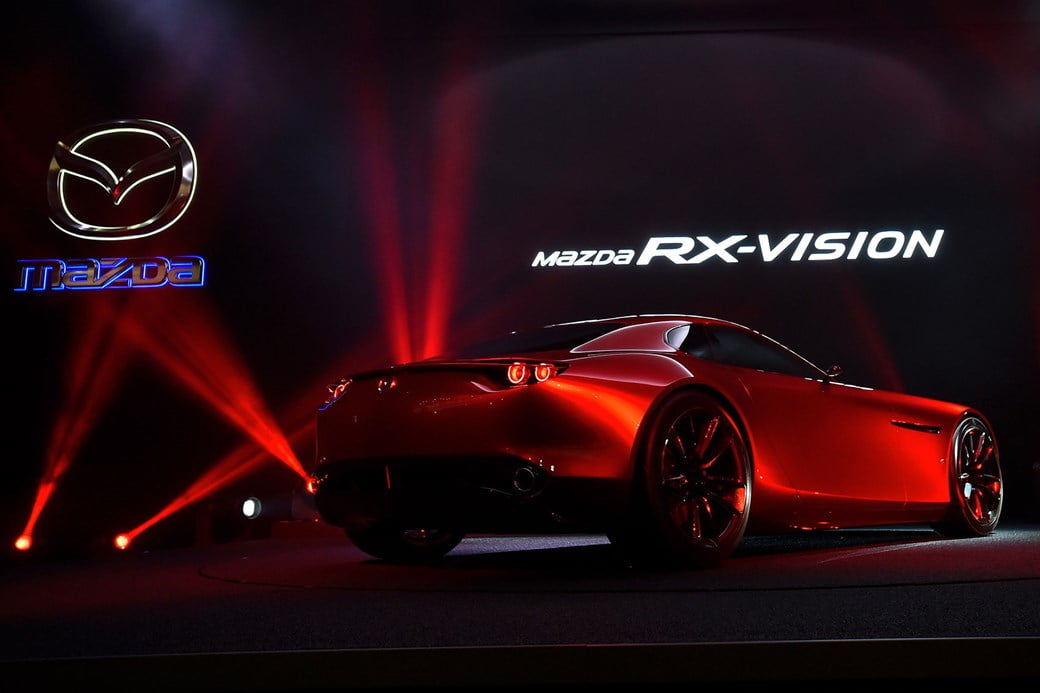You land bleary-eyed, rush through vast urban canyons teeming with traffic and arrive at the magnificent Big Sight exhibition centre absolutely convinced of one thing: Tokyo doesn’t need any more cars. And yet once again the city has laid on a show of delight and intrigue, from lounge-like autonomous Merc concepts to a sports car – the sensational RX-Vision – so refreshingly analogue that Mazda’s R&D boss Kiyoshi Fujiwara would dearly love to fit a six-speed manual, though he’s certain fashion will dictate a DCT.
Mazda ‘won’ the 2015 Tokyo show. It scored pretty well at Frankfurt with the Koeru crossover concept but RX-Vision was a sledgehammer blow, delivered at first light on day one to rapturous response. With an endless, impossibly low bonnet, fuss-free surfaces and classical detailing, it’s a timeless shape skillfully wrought. Veteran Mazda designer Ikuo Maeda rarely drops a duffer but this time even he seemed surprised by the adulation heaped upon his creation. Does production beckon? Certainly everyone at Mazda is desperate to see the RX on the road but there’s an awful lot of work to do. The company insists they showed a true concept, and that a production-ready car does not lurk in the wings, ready to go. It’ll also have its work cut out cleaning up the notoriously dirty and thirsty rotary engine, but then a release in 2017 – the original Cosmo rotary debuted in 1967 – would make for a very neat anniversary launch…
Is it still acceptable, in a world of warming skies and rising tides, to get giddy about sports cars? If there was a theme at Tokyo 2015 it was that the big Japanese manufacturers just weren’t sure. Mazda threw caution to the wind to great effect. Honda hedged their bets, putting the NSX and fuel cell Clarity centre-stage. Both had been seen before and yet their draw was undeniable; the former for the name, the complex Porsche 918-style performance hybrid powertrain and the latter because it’s a series-production fuel-cell car that doesn’t make you feel ill just looking at it.

The Clarity will be available on a lease basis imminently in Japan but is set to go on sale in the UK – you pay your money, you take your car – in late 2016. It’s an intriguing creation, with acres of space inside, a handsome, space-age interior, a big boot and of course a powertrain that emits nothing more harmful than water and 175bhp. Range is 430 miles, refueling takes moments and the price is high without being terrifying at around £55k. Honda says the UK infrastructure’s coming too, though early-adopters will need to be happy to live near Swindon.
If Mazda seems happy in the past and Honda equally content in a high-tech present, at Tokyo Nissan was all about the future. Carlos Ghosn spoke of ‘revolutionising the car/driver relationship’ as Nissan’s Silicon Valley research centre hurls the firm toward a new world of connected, intelligent electric vehicles. Ghosn is keen that the pioneer spirit that has served Nissan so well in crossovers and in EVs – 200,000 Leafs have been shifted; the latest version goes 20% further on a charge – should see it spearhead the move into autonomous cars and advanced driver assistance systems. He wants the brand to be as famous for zero fatality as it’s become for zero emissions. All three concepts – the Gripz, the IDS and Teatro for Dayz – were handsome and pretty transparent road signs to Nissan futures near, far and far-flung. By contrast Toyota tried to disguise a disappointing lack of content using on-stage ‘banter’ between CEO Akio Toyoda and a Japanese baseball star.
And the rest? Europe had a pretty good stab at stealing the headlines, or to be more specific the M4 GTS – the most powerful BMW road car ever – almost singlehandedly threatened to make a European car the biggest news in Japan. ‘A driving experience usually only found in purebred racing machine,’ promised M Division’s Frank van Meel with a smile so wide it threatened to drain the waters of Tokyo harbour. A welcome return to form for M Division? It certainly looks that way.

Porsche’s reveals (911 Carrera 4S and Macan GTS, both above) were low-key but perfectly judged. Japan loves the 911 (the car accounts for a third of sales, more than twice the global average), and when you note that the two new cars sat between Cayman GT4 (superb) and 911 GT3 RS (our recently crowned sports car of the year), you realise Stuttgart’s not getting much wrong at the moment.
Last time out, at Frankfurt, Gavin Green’s ‘car I’d most like to drive award’ went to Honda’s Project 2&4. Designer Martin Petersen was with his baby in Tokyo too, again making the case for production. ‘I’d like to use high-end components, like the 220bhp RCV engine, the six-speed DCT and the projector instruments, but there are cheaper alternatives – we could bring the cost down. And there are potential owners of trackday cars like this who like the idea but are uncomfortable buying from a small supplier. With Honda they’d have the peace of mind of a big OEM.’
[“source-carmagazine”]




